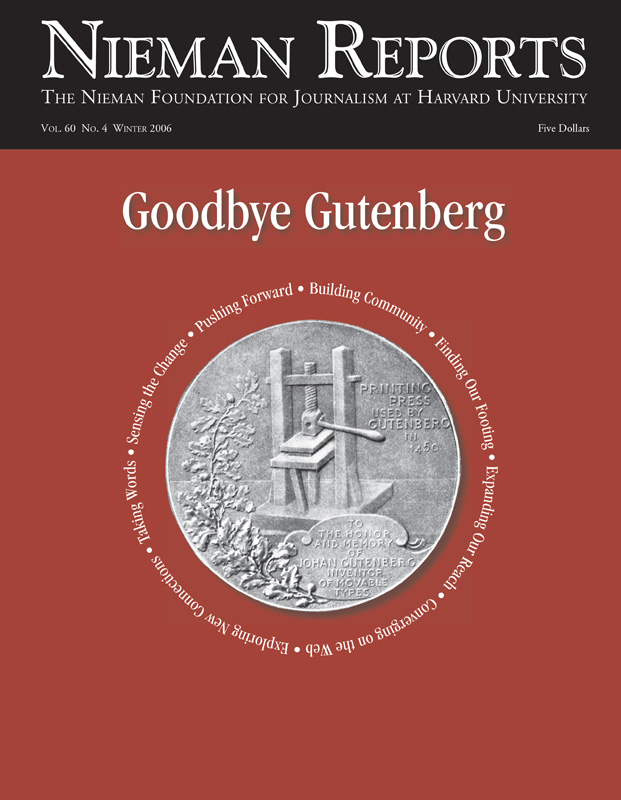In 1992, I helped produce a PBS television series about the history of the computer, grandiosely called the "Machine That Changed the World." The episodes recounted humankind’s failure to grasp that computers were not simply number crunchers. They were "universal machines" that could do just about anything — from processing words to arranging music, from decoding genes to editing video.
The computer did change the world, but not nearly as much as what followed it. The Internet, in 1992 a clumsy system linking university researchers, was about to morph into the World Wide Web, a seamless, user-friendly, global infrastructure connecting potentially every human on the planet. I never saw it coming.
Today, we’re all caught in the Web. Physically, it’s embodied as a planetary necklace of ultra pure glass, through which pulses of laser light whiz back and forth (we connect to this necklace either directly or by wireless). Culturally, its reach is much greater. For those pulses carry the world’s gossip, commerce, government and culture, along with our critical recording of events (our news). No field of human endeavor has escaped the Web’s reach.
On this glass highway, gossip has thrived: from cell phones — the fastest adopted global technology — to "spaces" where (mostly) young people show off, meet and hang out. Commerce, government and culture have also made smart uses of the Web: from online trading to public outreach, from international scientific collaborations to national archives.
As journalists, we think about what the Web means for work we do in reporting and disseminating news and information. Given its transformative capacity, we can regard the Web as a problem or we can see it as a potential solution to a broader problem that we would have had to face anyway.
Let’s look first at the problem. Arguably, the Web has exacerbated journalism’s RELATED WEB LINKS
MySpace
– www.myspace.com
Facebook
– www.facebook.com
YouTube
– youtube.comwoes, contributing to the loss of advertising, the consolidation of media ownership, the erosion of readership/audience (especially among the young) with traditional media, and the loss of public trust. It’s hard not to be offended watching media barons jostle to sell off "old" media assets like newspapers, radio and television stations and snap up "new" ones like, for example, the social exchange sites MySpace, Facebook and YouTube. Journalists fret that such outlets will lead to the abandonment of traditional core values of journalism, such as independence, autonomy, objectivity and fairness.
Engaging the Young
But there’s a more positive possibility. The Web may have arrived just at the right time to re-engage a generation that has abandoned newspapers. Why don’t they read? Partly because today’s 20-year-olds — who have grown up immersed in an audiovisual world of computers, video games, cable and satellite television — might be neurologically wired differently from their baby-boomer parents. A 2004 Michigan State study found that eighth-grade boys spend on average 23 hours a week — that’s nearly an entire day each week — playing video games (girls spend about half as much). Even college-age males average 16 hours a week of gaming. According to The John D. and Catherine T. MacArthur Foundation, "On a typical day, more than half of U.S. teenagers use a computer and more than 40 percent play a video game." This generation’s gossip is also shared in audiovisual ways, with exchanges involving not only written and spoken words but photos, videos and music.
Different wiring doesn’t mean dumber wiring. While middle-aged professors moan about today’s students’ poor grammar, by other measures the MySpace generation is the smartest in history. Historically referenced IQ scores have been rising steadily since World War I, by a few points a decade. If you accept that IQ tests measure intelligence, then the world is getting smarter. Today’s average child (with a score of 100) would have been considered a near genius 50 years ago (scoring around 115, as measured against the 1956 average).
This strange phenomenon of rising IQ scores is known as the "Flynn effect," named after the New Zealand-based psychologist James R. Flynn who uncovered it. And most significantly, the tests that show the greatest gains are abstract and visual. Students who might struggle with a history essay make short work of tests like Raven’s Progressive Matrices. In this nonverbal intelligence test measuring spatial reasoning, subjects are presented with a series of figures with a missing piece. They must choose the correct piece from a set of similar looking choices, and their scores beat out all previous generations of test takers.
A generation reared on video games is primed for an interactive multimedia platform like the Web. Indeed, the love fest between the MySpace generation and the Web may signal a profound moment in human culture. With the Web, we could be witnessing the most important development in expressive media since the advent of writing. One exciting if disruptive possibility is that under the influence of the young, the Internet will usher in a new era of interactive, audiovisual literacy. Though written words will remain critical to human communication, it’s likely they will no longer dominate in the exchange of news and information.
Journalists will have to meet this challenge — or perish.
New Ways of Telling Stories
Before the Web, storytelling was platform specific. Newspapers and magazines focused on text and photos, radio told stories with audio, and television dealt with moving pictures and sounds. Each platform has its tools and specialized skill sets, advantages and disadvantages. The Web forces these platforms to integrate. Today’s best media Web sites are multimedia productions combining text, stills, audio and video.
Over time, how will the Web, our first meta-platform, change our media landscape? I suspect our platform distinctions will not be completely eroded — nor will it lead to a total convergence among them, either — since, after all, the various platforms relate to sights, sounds and language, which are the primary channels that humans use to communicate. But the Web will likely force television, radio and print journalists to get to know each other better. By bringing these formats together, the Web should facilitate complementary storytelling approaches, something that should enrich the journalistic enterprise.
These speculations should be taken with a large pinch of salt. Media technologies have a history of developing in unpredictable ways, surprising even their pioneers. In 1947, for example, the Harvard computer engineer Howard Aiken argued that six electronic computers would satisfy the United States’s computing needs. There was no way that he could imagine that one day there would be hundreds of millions of them used (mostly) for anything but arithmetic.
So my vision of what’s ahead could be quite wrong. But if I’m right, the Web arrived just in time to re-engage what has turned out to be the MySpace generation. And even if old media continue their decline, there is still hope. Perhaps, with some guidance from us, our newly minted game-playing journalism graduates will find ways to reinvent the art of storytelling in the age of the World Wide Web.
Jon Palfreman, a 2006 Nieman Fellow, is KEZI Distinguished Professor of Broadcast Journalism at the University of Oregon. A veteran of both U.K. and U.S. television, he has made more than 40 BBC and PBS one-hour documentaries including the Peabody Award-winning series the "Machine That Changed the World," the Emmy Award-winning NOVA "Siamese Twins," and the Alfred I. duPont-Columbia University Silver Baton-winner, "Harvest of Fear."



